Baby squirrels might arguably be among the cutest babies in the animal kingdom. They’re so tiny, fragile, helpless, and cuddly. If you have found a litter of tiny baby squirrels and their mother is nowhere to be found, you might be scrambling around to find resources to help. Or maybe you are into exotic pets and want to keep squirrels. They can make decent pets for experienced owners.
No matter where you are on your journey, don’t fret. We go over exactly how to approach the situation so you can appropriately care for these speedy critters.

Squirrel Facts
Squirrels are awesome little mammals that love to get into mischief. No matter what kind of squirrel you’re looking at, these little critters are super amiable, curious, and attentive—and boy, do they have energy! But do squirrels make good pets?
Let’s get to know squirrels a little better.
History
Squirrels are indigenous to North America, South America, Asia, Europe, and Africa, and they were introduced to Australia. In different regions of the world, squirrels vary in appearance and personality. Despite their wild nature, some exotic pet enthusiasts have tried domesticating this little critter.
Believe it or not, squirrels were popular pets in the past. They were found in many homes across the U.S. throughout the 1800s. Squirrels had agile bodies and endearing personalities, winning over the hearts of their keepers.
Today, many wildlife professionals advise people to not keep squirrels as pets, but that doesn’t stop some from trying it.
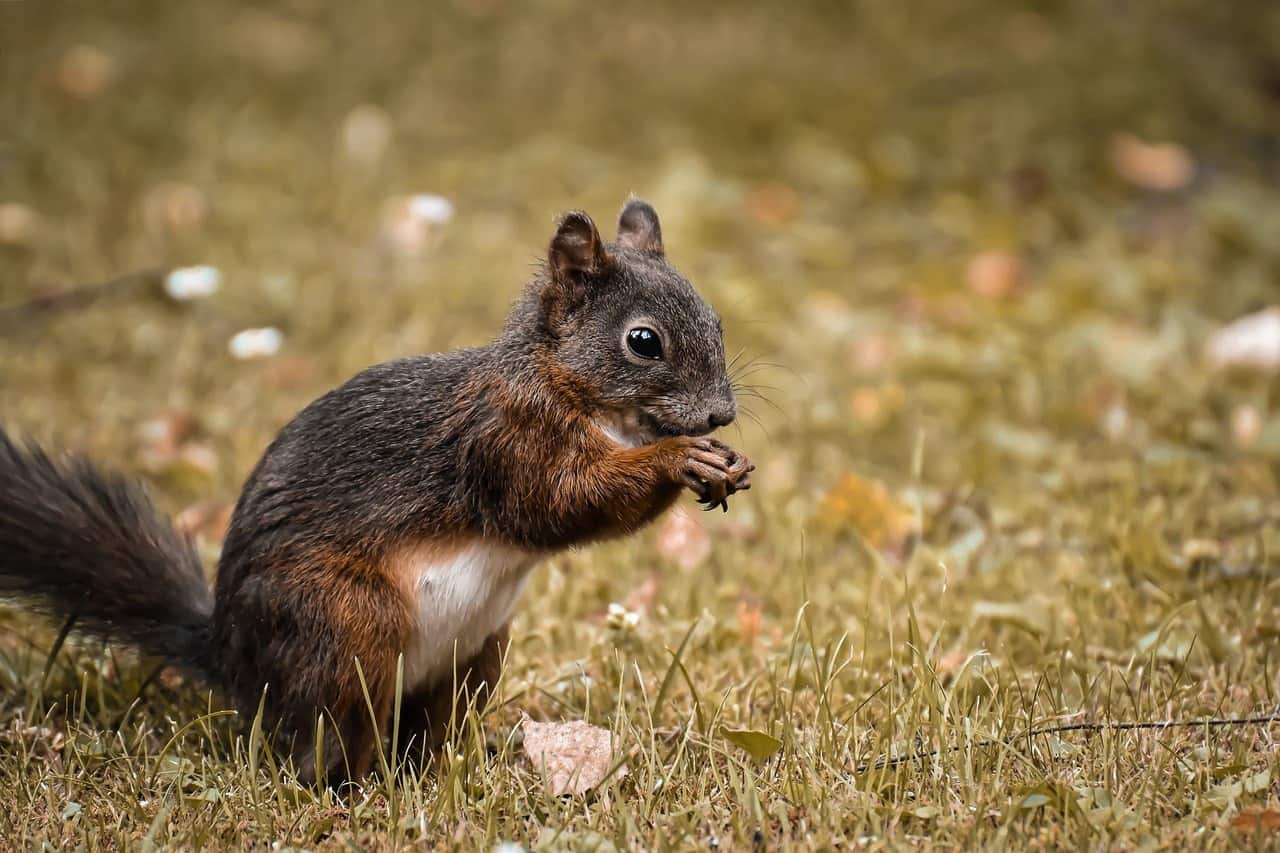
Types of Squirrels
There are a few different species of squirrel, including:
- Flying squirrels
- Ground squirrels
- Tamias
- Fox squirrels
- Eastern gray squirrel
- Tree squirrels
- American red squirrels
- Black squirrels
Environment
Squirrels prefer to live in trees and inhabit woodland areas. Squirrels also love urban developments. Even though they might face additional danger in suburbs or cities, they have a plentiful food selection.

Lifespan
Lifespans for squirrels vary depending on species and environment. For example, it’s not unusual to see a gray squirrel live 20 years in captivity.
Colors
Depending on species, squirrel coats can vary between:
- Black
- Brown
- Agouti
- White
- Red
- Silver
Natural Diet
Squirrels are herbivores and eat a diet of plants, fruits, vegetables, seeds, nuts, and bark. They might also hop into a backyard to steal bird seed.
- Related Read: What Do Flying Squirrels Eat in the Wild and as Pets?
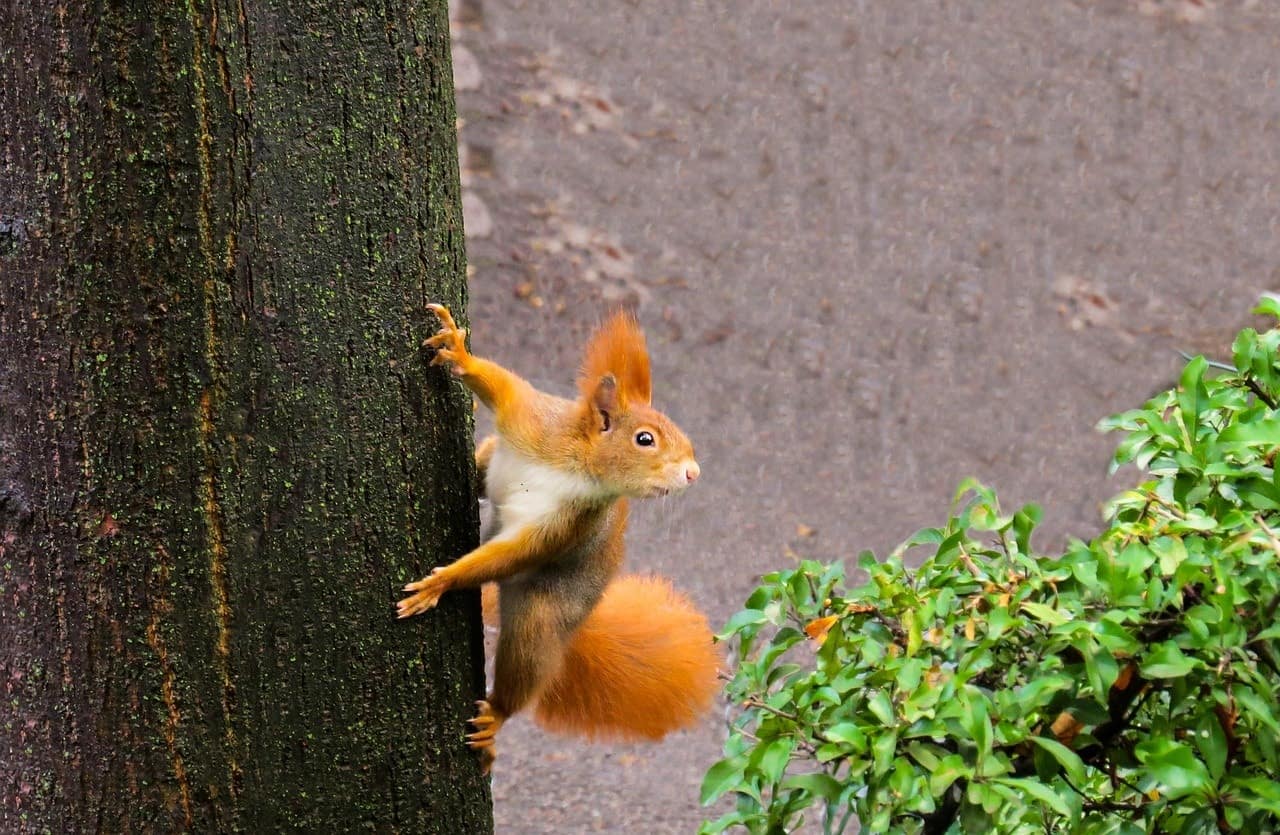
Do Squirrels Make Good Pets?
Squirrels are compact, excitable little cuties that have interactive personalities. Some people find owning a squirrel to be a rewarding experience. However, there can be several downsides that make squirrel owning not the best decision.
Region Laws & Regulations on Exotic Pets
All else aside, it is challenging to obtain licensing, and it’s sometimes illegal to own pet squirrels. Certain states and regions have stringent requirements or forbid it altogether. Some areas want you to have wildlife rehabilitation licensing before having a squirrel, to ensure proper care.
If you’re curious about laws in your state, this map gives a color-coded view of the United States. Check out your general laws for exotic animal owning before you move forward to purchase or obtain a license. All places that require licensing want you to have the proper documentation before you bring home your squirrel.

The Reality of Owning a Squirrel
No matter how cute they are, these animals are still considered wild. Even if you buy from a breeder, squirrels haven’t been out of their natural habitat long enough for total domestication. This means squirrel owning is quite unlike having a dog or cat.
Squirrels have a high prey response, which means they will flee, bite, or claw whenever they feel threatened. One wrong move might signal that there is danger, creating a bad reaction. Squirrels have muscular, powerful legs and sharp teeth, meaning they can pack quite a punch.
By nature, squirrels are meant to leap from tree to tree with no consequence. They have limitless energy and a sense of freedom. Confined squirrels with small habitats can get lonely and even depressed without proper socialization and stimulation.
When they get out to roam, they have sharp claws that will tear up furniture and other materials. All out-of-cage explorations should be closely supervised.

Complications of Squirrel Care
Some people aren’t prepared for squirrel owning for various reasons. Either this is an abandoned infant situation or an impulse buy. Regardless of the reason behind the hardship, you might find yourself in over your head.
For example, squirrels might surprise you with how much attention they need. Not only do you have to let them out for daily exercise faithfully, but you also have to make sure they are clean, fed, and cared for.
Vetting can get pricey too, since exotic vets are rare and have high rates and fees. Sometimes people find themselves unaware of how to continue care and will surrender the animal.
Injured or Wounded Squirrels
If you found a litter or singular baby squirrel that was abandoned or injured, they might not be able to go back to the wild. Even if your initial plan was to nurse the baby back to health and release it, that’s not always an option.
In this situation, you should always contact a wildlife rescue or rehabilitation center for further guidance or advice.

Where Can I Get a Baby Squirrel?
Where you can buy a baby squirrel depends greatly on where you fall on the map. Some places allow you to keep squirrels as pets, while others strictly forbid it. Squirrels are considered wild animals, so most places do request that you have a permit and proper licensing before ownership. Cost varies quite a bit from state to state, falling anywhere from $5 to $150.
Some baby squirrels will be free, since you might find an abandoned infant. But others will cost you. A squirrel from a licensed breeder costs about $200 to $600, but they can be upward of $1,000, depending on rarity.

What Kind of Home Does My Baby Squirrel Need?
A baby squirrel does best in a natural nest or burrow, but accidents do happen. If you find an orphaned baby squirrel, reach out to a wildlife facility on how to proceed.
If you’re buying a squirrel from a breeder, you need to mimic their natural lifestyle as much as possible in captivity.

Nesting
Squirrels nest naturally, which gives them a sense of security. They are also great architects. If you give your squirrel plenty of rodent-friendly materials, they can make an amazing nest all by themselves.
Toys
Squirrels are playful little critters, and they will need activities to keep them occupied. They also need many safe objects to chew on, since they have to regularly file down their incisors.
Cage Type
Squirrels are energetic and require a large amount of space, so the bigger the cage, the better. A squirrel can fit well in a tall, vertical cage where they can jump and climb. Many ferret or sugar glider cages can be suitable homes for pet squirrels, provided that they also have daily time to explore outside of the cage.
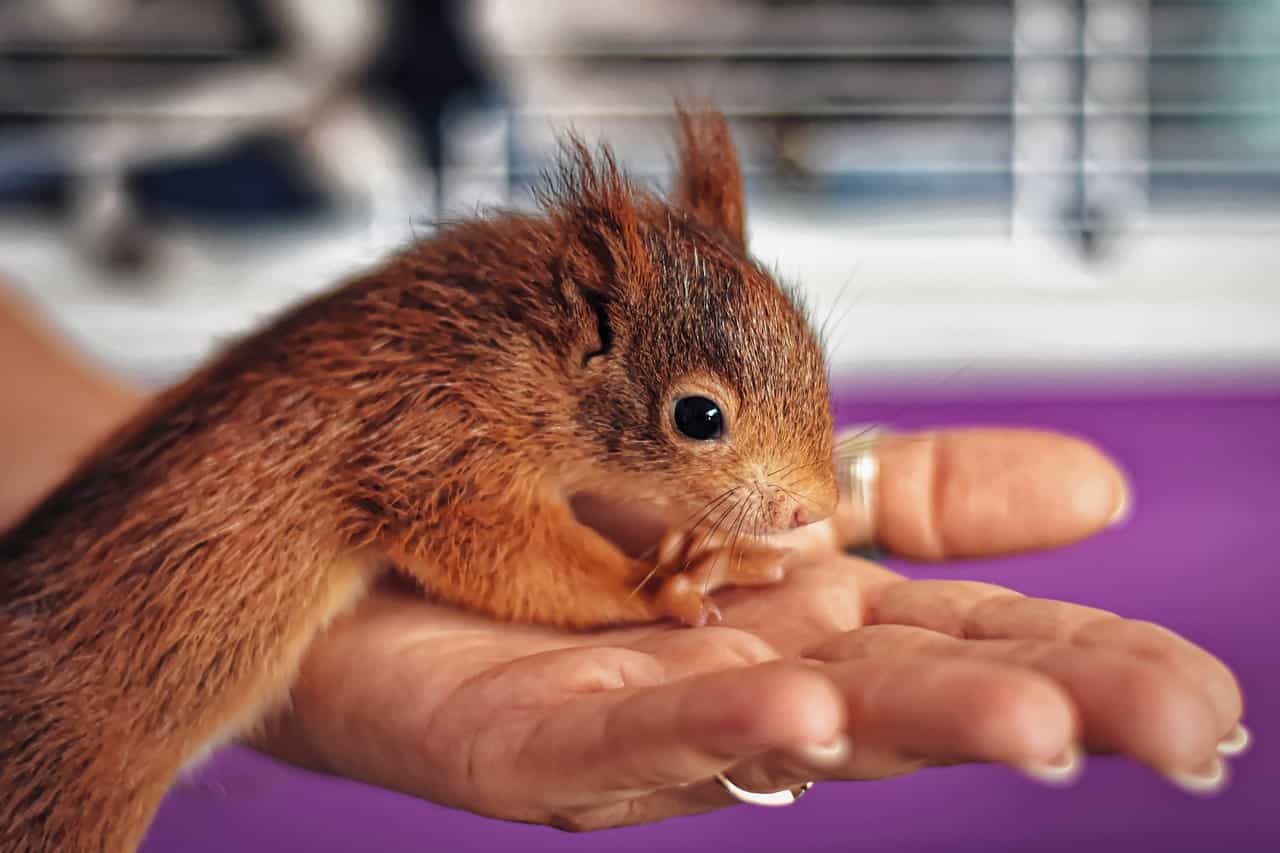
Hides
Squirrels prefer to feel secluded when they relax. They also love having a private stash called a “cache” to store food overflow.
Food & Water Dishes
You can give your squirrel a regular shallow food dish, since they will likely remove all the food and horde it in their nesting area. Squirrels also need a water bottle, such as the one that you would buy for guinea pigs or rabbits.
Cage Mates
In nature, squirrels typically live alone, so they won’t need a cage mate. They’re also not good with other pets because they can be hurt so easily.

What Should I Feed My Baby Squirrel?
The squirrel’s diet depends on the age of the baby.
Orphaned Babies
If the squirrel is orphaned, you have to bottle feed the baby every few hours. They need puppy formula replacement milk and Pedialyte to grow appropriately. You will have to narrow down the age of the babies to determine how much to offer.
You’ll also need to follow a rigorous feeding schedule, which means being up every few hours throughout the night to ensure that they are fed and groomed. This can be incredibly taxing, as very young squirrels need to eat every 2 hours for the first several days of their lives.
In addition to feedings, you must be prepared to do all of the mother’s work, including stimulating the genitals to help them use the bathroom. If you don’t, the squirrel might get bound up and impacted, being unable to pass their stool.
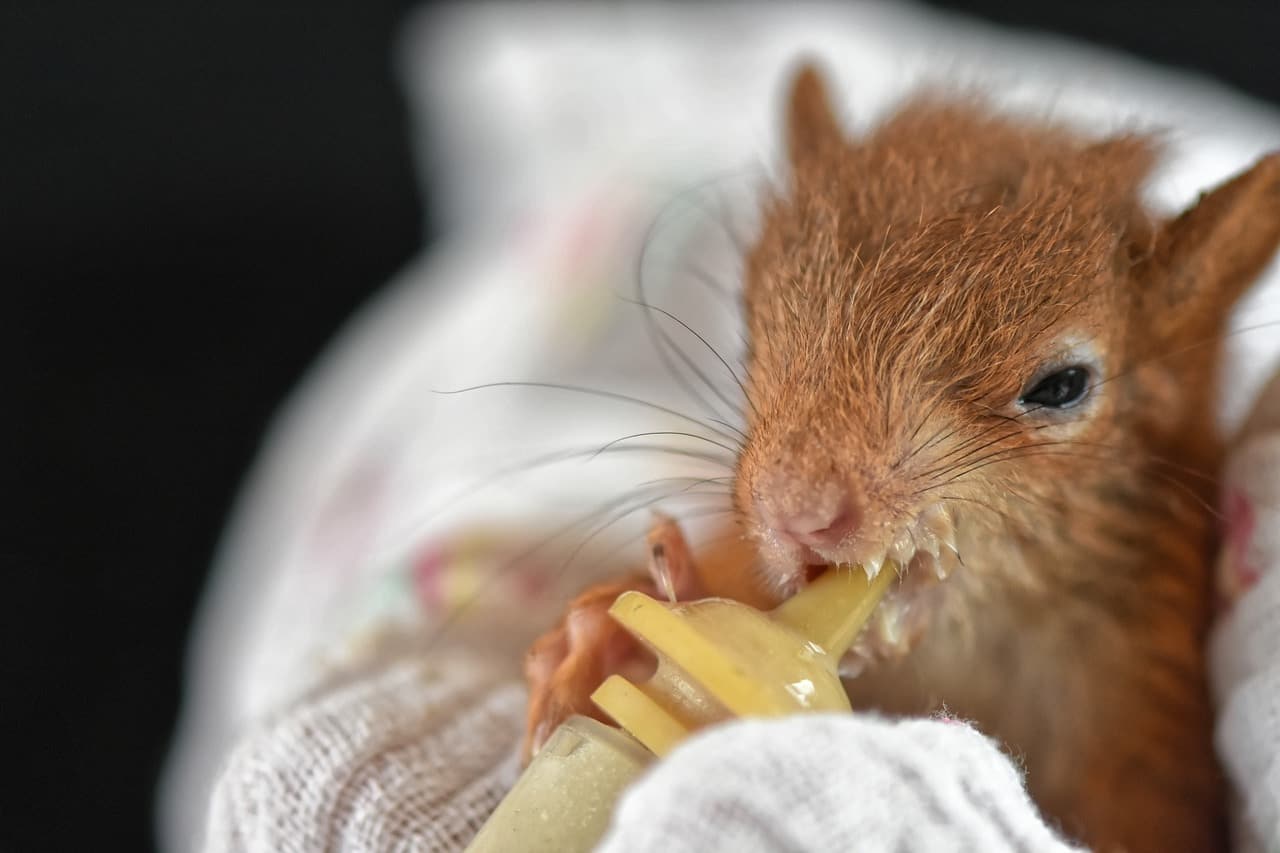
Captive Babies
Squirrels born in captivity won’t leave their mothers until they are roughly 10 and 12 weeks of age. By this time, you won’t have to worry about supplementing formula, as the babies are completely weaned and ready to live self-sufficiently.
- Rodent block
- Vegetables
- Wild roots and greens
- Nuts
- Seeds
- Fruit
- Bark
Most of their dietary needs are covered by rodent blocks alone, but fresh foods are essential to keep your squirrel healthy.

How Do I Take Care of My Baby Squirrel?
If you’re keeping a squirrel in captivity, you want to create the best atmosphere possible.
Cage Temperature
If your squirrel is very young, you will need to keep them warm and cozy, as these little ones rely on their mother’s body heat in the beginning. You might need a heating lamp or pad for the first several weeks of rehabilitation.
Self-sufficient squirrels are durable and made to withstand the elements. They should be in a room-temperature area away from drafts or direct sunlight.
Socialization
Squirrels are energetic little rascals that need plenty of time for socializing. They are incredibly curious and can form close bonds with people. They will connect with you the most when they are enjoying playing. So, getting your squirrel out of their enclosure for fun activities will strengthen your relationship.
With proper restraints and supervision, you can even take your squirrel outside to explore. Do exercise caution, as they can slip away in the blink of an eye.

Exercise
Squirrels are chipper little animals that need time to scurry about. They also need plenty of sunshine, so daily trips outside in 30-minute intervals are ideal.
Cleanup
You have to keep your squirrel’s cage area clean and sanitary. It would be best to spot clean the cage to keep it accident free. You should clean the entire cage every week.
Grooming
Your squirrel will do all the complicated grooming work for you. You won’t have to bathe them, but you will have to trim their nails. If you are unfamiliar or uncomfortable with performing this task, take them to the vet for assistance.
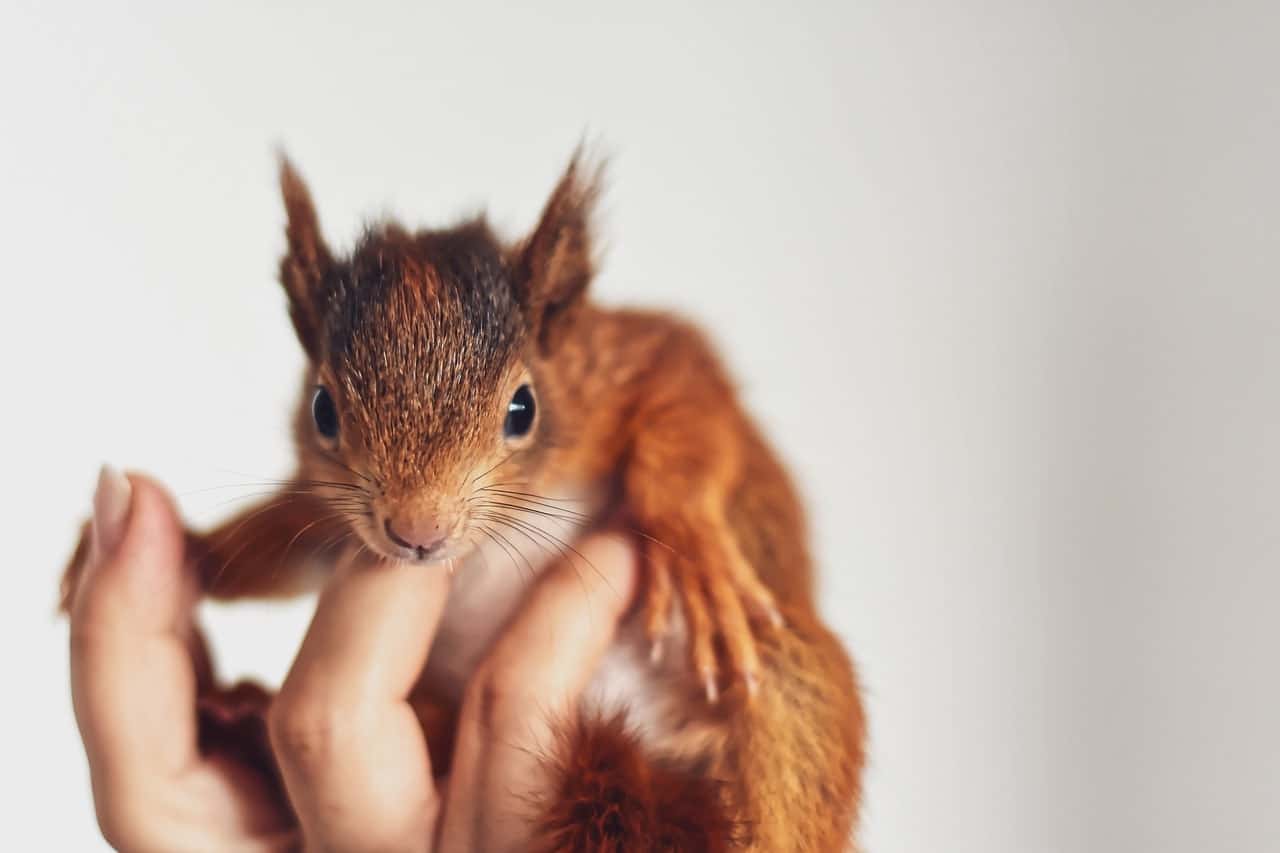
How Do I Know If My Baby Squirrel Is Sick?
If you find a baby squirrel, look for visible signs of problems like scratches, wounds, or trauma. If there’s nothing visually unusual, pay attention to their breathing and response. You’ll need to tend to the baby squirrel right away if it seems very weak or cold.
With exotic pets, it’s vital to get them to wildlife professionals who have experience. Many problems will be out of your scope of expertise, which can be detrimental to the baby.
If you bought your squirrel from a breeder, you still need to make sure your little livewire is growing and functioning as it should. Find an exotic vet in your area and keep up with annual vet visits.
Squirrel Health Issues
There are certain illnesses that your squirrel can contract, but there are also problems they can pass along to you. Even domestically bred squirrels might still carry diseases.
Veterinary testing can determine the health of your baby squirrel. Take your little critter to appointments faithfully, especially in their first year of life.
- Leptospirosis
- Salmonellosis
- Parasites
- Lyme disease
- Tularemia
Protect yourself while interacting with your squirrel to prevent the transmission of bacteria. Always remember to guard your skin and wash your hands afterward.
Signs of Sickness
Squirrels are bright eyed and bushy tailed. They’re zippy, alert, and quick on their feet. All healthy squirrels should carry these characteristics, so if you notice that they aren’t acting like themselves, look for other visual cues to see what might be wrong.
If your squirrel shows any of these signs, contact a professional right away:
- Sneezing
- Runny nose or eyes
- Lethargy
- Abnormal behavior
- Rapid breathing
- Lackluster coat
- Dim eyes
Don’t hesitate to take your pet in immediately if you think that it’s an emergency situation.
How Do I Prepare My Baby Squirrel to Live in Nature?
Letting a baby squirrel live its life in its natural habitat is the best decision that you can make for the cute little nut lover. It might be hard to give it up once you’ve found and bonded with a squirrel, but it really does give it an optimal quality of life.
Many agencies littered across the U.S. work with people to rehabilitate and release wildlife back into the woods. You can trust a professional to reintroduce the squirrel to its natural roots.
Contacting a Wildlife Rescue in Your Area
Wildlife rescues are available in every state. Here is a list of facilities by state that can help out, but there may be more options for you locally.

Final Thoughts
Whether you’re deciding to bring home a baby squirrel from a breeder or just rescued a litter, squirrel care is essential to the well-being of these amazing creatures. However, owning a squirrel might not be what you think.
These critters are wild animals that are the happiest in their natural habitats. If you do own a pet squirrel, always take care of all aspects requiring attention—from diet and enclosure to daily exercise. Most importantly, enjoy interacting with your bustling little rodent.
- Here’s an interesting thought: What Do Squirrels Eat?
Featured Image Credit: Pixabay
